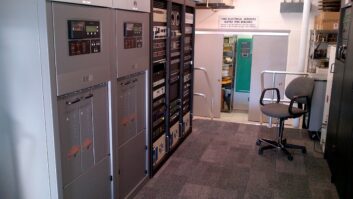Radio Applications of Fuel Cells
Feb 1, 2010 12:00 PM, By Kevin McNamara
Your choices for powering a transmitter or studio site now include the use of a technology invented in 1839: The fuel cell. Until recently, the costs to purchase and install fuel cells have been prohibitive; but, lower costs, more choices of fuel and federal tax incentives might make them a viable alternative for your facility.
In simple terms the fuel cell is a device that combines hydrogen and oxygen creating an electrochemical reaction that produces heat, water and electricity. The hydrogen is produced from common hydrocarbon-based fuels such as natural gas, gasoline, diesel or methanol. Oxygen is pulled from the air around it. The combination produces a chemical reaction, not completely unlike a standard battery. The fuel cell is essentially a battery with a system that constantly feeds the proper fuel into the cell. The process does not use combustion and as such produces no emission products.

The components of a proton-exchange membrane fuel cell. Click here to enlarge.
There are several types of fuel cells, particularly for higher-power applications, but they are expensive and tend to operate at very high temperatures (up to 1,000 C). However, the Polymer Exchange Membrane Fuel Cell (PEMFC) is the technology currently used for the small-scale power generation used for transportation and other power applications. PEMFC systems operate at a lower temperature (less than 180 F) and have a higher efficiency. The most common fuels are LP or natural gas.
The system components
A fuel cell is created with six basic process components.
- Fuel Processor/Reformer � This system extracts the hydrogen from the hydrocarbon fuel. The generic term reforming is generally applied to the process of converting liquid or gaseous light hydrocarbon fuels to hydrogen and carbon monoxide. This process separates the fuel into hydrogen, water, carbon monoxide and heat.
- Electrodes � As in any battery, there is an anode (negative) and a cathode (positive). The anode has channels that disperse the hydrogen gas equally over the surface of the catalyst. The hydrogen molecules are split into positively charged ions, giving up one electron each. The positively charged ions then migrate through the electrolyte to the positive post (cathode). The negatively charged electrons travel through the external circuit to produce electric energy.
- Electrolyte � The electrolyte transports the positively charged hydrogen ions to the cathode in order to complete the electric circuit. In addition, it provides a physical barrier to prevent the fuel and oxidant gas streams from directly mixing.
- Oxidant � Typically oxygen that is pulled from the air surrounding the fuel cell. The oxidant is channeled through the cathode.
- Fuel Cell Stack � Each fuel cell produces 0.7V. Several fuel cells are connected together to produce the desired output, 12V or 24V are most common.
- Power conditioning � converts and/or conditions the dc power to ac (if desired). Fuel cells typically need some time to start producing power; many systems utilize capacitor banks to store power to ensure a constant power source in the event of transfer from grid power to fuel cell, this gives the fuel enough time to start while providing uninterrupted power.
— continued on page 2
Radio Applications of Fuel Cells
Feb 1, 2010 12:00 PM, By Kevin McNamara
Applications and limitations
There are thousands of fuel cell power systems deployed in telecommunications applications in the U.S. Wireless telephone carriers are some of the biggest adopters of the technology since fuels cell systems provide much longer runtimes for backup power applications. There is also very little maintenance for fuel cells as compared with the need to replace batteries every two years or the costs to maintain thousands of backup generator systems. Perhaps the largest benefit is the ability of the fuel cell systems to operate continuously over long periods of time. Since Hurricane Katrina, the federal government has mandated that wireless carriers maintain 8 hours of backup power (at a minimum) at each site. When compared with the traditional battery-backup system, fuel cells provide longer runtimes for a given footprint. The runtime is only limited by the size of the fuel supply. The fuel cell also weighs much less than the amount of lead acid batteries required for the extended operation � this is a real consideration when located in the upper floor of a building.
In terms of broadcast applications, PEMFC systems would not be suitable to run full power transmitter sites. The largest PEMFC systems will provide up to 7kW of dc power. The systems can be ganged to increase the capacity, if necessary. In practical use, these systems are most suitable for applications where you now use large battery-based, uninterruptable backup power systems. These might include data centers, engineering rooms, small studios, remote trucks, remote microwave sites and low power backup transmitter sites. Fuel cells would also be the ideal power source for any emergency plans such as portable, trailer-mounted, low-power emergency transmitter systems and studios.
Cost
Cost for PEMFC systems are about $3,000 per kilowatt, that would make the cost of a 5kW system approximately $15,000. Installation might add another $2,000. While $17,000 is a little higher than the equivalent battery-based UPS or generator backup, tax credits could lower the purchase price of the PEMFC $5,000 or more putting it well within range of the traditional methods. Also when you consider the total cost of maintenance over 5, 10 or 15 years between a generator or battery UPS, the PEMFC becomes about 30 percent cheaper, since there are no expensive batteries to replace and dispose. Fuel cells have no moving parts, which eliminates the mechanical issues and repairs found in reciprocating, engine-driven generator systems. Perhaps the greatest benefit of PEMFC systems is that they are considered a green power alternative, which gives your company some bragging rights.
Other considerations
The installations of PEMFCs are specifically addressed in all national and most state and local building codes including NFPA and IBC. A lot of the differences between fuel cells and other power systems in the codes have to do with the handling of the fuel, fuel piping, ventilation and location of the system.
McNamara is president of Applied Wireless, Cape Coral, FL.
Want to know more about PEMFC and other fuel cell systems? The U.S. Department of Energy has a site dedicated to efficient and renewable energy sources including fuel cells. www.eere.energy.gov






